.
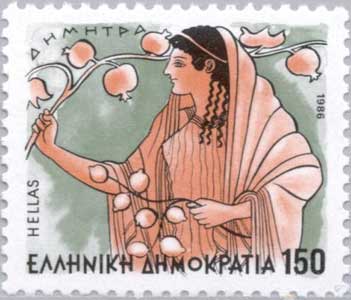
Dêmêtêr (or Demetra) (DEH-MEH-ter)(Δήμητρα) ("mother-goddess" or perhaps "distribution-mother") is the Greek goddess of agriculture, the pure nourisher of youth and the green earth, the health-giving cycle of life and death, and preserver of marriage and the sacred law. She is invoked as the "bringer of seasons" in the Homeric hymn, a subtle sign that she was worshiped long before the Olympians arrived. She and her daughter Persephone were the central figures of the Eleusinian Mysteries that also predated the Olympian pantheon.
The Roman equivalent is Ceres
Demeter is easily confused with Gaia or Rhea, and with Cybele. The goddess's epithets reveal the span of her functions in Greek life. Demeter and Kore ("the maiden") are usually invoked as to theo ('"The Two Goddesses"), and they appear in that form in Linear B graffiti at Mycenaean Pylos in pre-Hellenic times. A connection with the goddess-cults of Minoan Crete is quite possible.
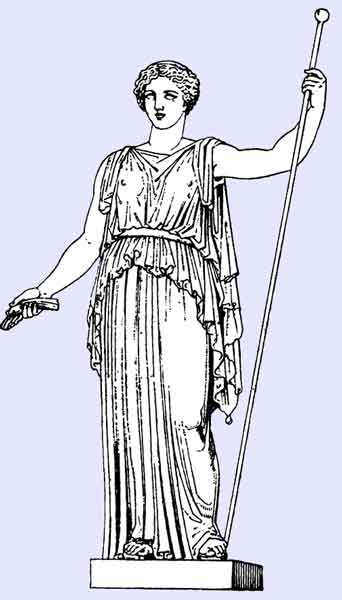
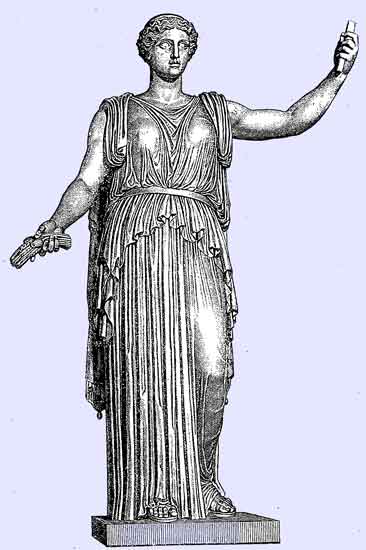
Ceres (Demeter), Sculpture Vatican Rome.
Titles and functions
In various contexts, Demeter is invoked with many epithets:
Deo (Δηώ). a name for Demeter; hence her daughter Persephone is called by the patronymic Deois and Deoine (Callim. Frag. 48).
Potnia ("mistress") in the Homeric Hymn to Demeter
Chloe ("the green shoot", Pausanias 1.22.3), for her powers of fertility and eternal youth
Anesidora ("sending up gifts" from the earth Pausanias 1.31.4), as Demeter
Mallophora (Μαλλοφόρα). “Wool-bearing.” An epithet as worshipped at Megara, whose inhabitants she was fabled to have taught the use of wool (Pausanias. i. 44).
Kidaria (Pausanias 8.13.3),
Chthonia ("in the ground" Pausanias 3.14.5)
Erinys ("implacable," Pausanias 8.25.50)
Lusia ("bathing", Pausanias 8.25.8)
Thermasia ("warmth," Pausanias 2.34.6)
Kabeiraia, a pre-Greek name of uncertain meaning
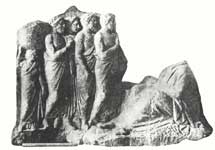
Thesmophoros ("giver of customs" or even "legislator"), a role that links her to the even more ancient goddess Themis. This title was connected with the Thesmophoria, a festival of secret women-only rituals in Athens connected with marriage customs.
Theocritus remembered an earlier role of Demeter:
For the Greeks Demeter was still a poppy goddess
Bearing sheaves and poppies in both hands. — Idyll vii.157
In a clay statuette from Gazi (Heraklion Museum, Kereny 1976 fig 15), the Minoan poppy goddess wears the seed capsules, sources of nourishment and narcosis, in her diadem. "It seems probable that the Great Mother Goddess, who bore the names Rhea and Demeter, brought the poppy with her from her Cretan cult to Eleusis, and it is certain that in the Cretan cult sphere, opium was prepared from poppies" (Kerenyi 1976, p 24).
In honor of Demeter of Mysia a seven-day festival was held at Pellené in Arcadia (Pausan. 7. 27, 9). It lasted for seven days. Pausanias passed the shrine to Demeter at Mysia on the road from Mycenae to Argos but all he could draw out to explain the archaic name was a myth of an eponymous Mysius who venerated Demeter.
Major sites for the cult of Demeter were not confined to any localized part of the Greek world: there were sites at Eleusis, in Sicily, Hermion, in Crete, Megara, Celeae, Lerna, Aegila, Munychia, Corinth, Delos, Priene, Akragas, Iasos, Pergamon, Selinus, Tegea, Thorikos, Dion, Lykosoura, Mesembria, Enna, Samothrace
She was associated with the Roman goddess Ceres. When Demeter was given a genealogy, she was the daughter of Cronos and Rhea, and therefore the elder sister of Zeus. Her priestesses were addressed with the title Melissa.
Demeter taught mankind the arts of agriculture: sowing seeds, ploughing, harvesting, etc. She was especially popular with rural folk, partly because they most benefited directly from her assistance, and partly because rural folk are more conservative about keeping to the old ways. Demeter herself was central to the older religion of Greece. Relics unique to her cult, such as votive clay pigs, were being fashioned in the Neolithic. In Roman times, a sow was still sacrificed to Ceres following a death in the family, to purify the household.
Demeter and Poseidon
Demeter and Poseidon's names are linked in the earliest scratched notes in Linear B found at Mycenaean Pylos, where they appear as PO-SE-DA-WO-NE and DA-MA-TE in the context of sacralized lot-casting. The 'DA' element in each of their names is seemingly connected to an Indo-European root relating to distribution of land and honors (compare Latin dare "to give"). Poseidon (his name seems to signify "consort of the distributor") once pursued Demeter, in her archaic form as a mare-goddess. She resisted Poseidon, but she could not disguise her divinity among the horses of King Onkios. Poseidon became a stallion and covered her. Demeter was literally furious ("Demeter Erinys") at the assault, but washed away her anger in the River Ladon ("Demeter Lousia"). She bore to Poseidon a Daughter, whose name might not be uttered outside the Eleusinian Mysteries, and a steed named Arion, with a black mane. In Arcadia, Demeter was worshiped as a horse-headed deity into historical times.
Disagreement: The etymology of "Demeter" is well attested as "Deus Mater", or Divine Mother or God Mother. The root "De" is the same as found in "Zeus", "Deus", and "Theos", all of which are cognates. The "-us" suffix may denote masculine gender, as with the translation of "Yeshua" into Greek as "Iesous", or with Odysseus and Achilleus, etc.
Demeter and Persephone
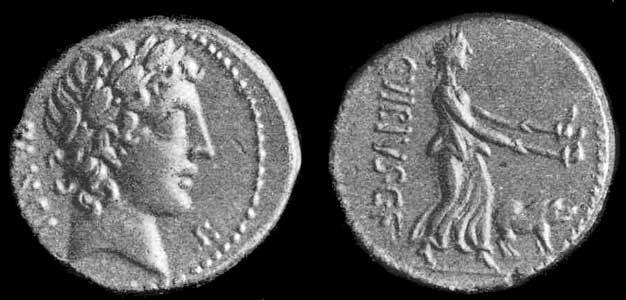
Silver Denarius, C. Vibius Pansa, c. 90 BC, Apollo Head, Demeter searching for Persephone
The central myth of Demeter, which is at the heart of the Eleusinian Mysteries is her relationship with Persephone, her daughter and own younger self. In the Olympian pantheon, Persephone became the consort of Hades (Roman Plutus, the underworld god of wealth). Persephone became the goddess of the underworld when Hades abducted her from the earth and brought her into the underworld. She had been playing with some nymphs (or Leucippe) whom Demeter changed into the Sirens as punishment for not having interfered. Life came to a standstill as the depressed Demeter (goddess of the earth) searched for her lost daughter (resting on the stone, Agelasta). Finally, Zeus could not put up with the dying earth and forced Hades to return Persephone by sending Hermes to retrieve her. But before she was released, Hades tricked her into eating six pomegranate seeds, which forced her to return six months each year. When Demeter and her daughter were together, the earth flourished with vegetation. But for six months each year, when Persephone returned to the underworld, the earth once again became a barren realm. The six months when the earth is barren are the summer months, since in Greece this is when all vegitation dies from heat and lack of rainfall. The winter by comoparison has heavy rainfall and mild temperatures in which plant life flourishes. It was during her trip to retrieve Persephone from the underworld that she revealed the Eleusinian Mysteries. In an alternate version, Hecate rescued Persephone.
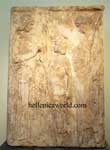
126 : Votive relief. Demeter, Kore and Triptolemos, Pentelic marble.
While Demeter was searching for her daughter, having taken the form of an old woman called Doso, she received a hospitable welcome from Celeus, the King of Eleusis in Attica (and also Phytalus). He asked her to nurse Demophon and Triptolemus, his sons by Metanira. As a gift to Celeus, because of his hospitality, Demeter planned to make Demophon immortal by burning his mortal spirit away in the family hearth every night. She was unable to complete the ritual because Metanira walked in on her one night. Instead, Demeter chose to teach Triptolemus the art of agriculture; from him the rest of Greece learned to plant and reap crops. He flew across the land on a winged chariot while Demeter and Persephone cared for him, and helped him complete his mission of educating the whole of Greece on the art of agriculture.
Later, Triptolemus taught Lyncus, King of the Scythians the arts of agriculture but he refused to teach it to his people and then tried to kill Triptolemus. Demeter turned him into a lynx.
Demeter was usually portrayed on a chariot, and frequently associated with images of the harvest, including flowers, fruit, and grain. She was also sometimes pictured with Persephone.
Demeter is not generally portrayed with a consort: the exception is Iasion, the youth of Crete who lay with Demeter in a thrice-ploughed field, and was sacrificed afterwards— by a jealous Zeus with a thunderbolt, Olympian mythography adds, but the Cretan site of the myth is a sign that the Hellenes knew this was an act of the ancient Demeter.
Demeter placed Aethon, the god of famine, in Erysichthon's gut, making him permanently famished. This was a punishment for cutting down trees in a sacred grove.
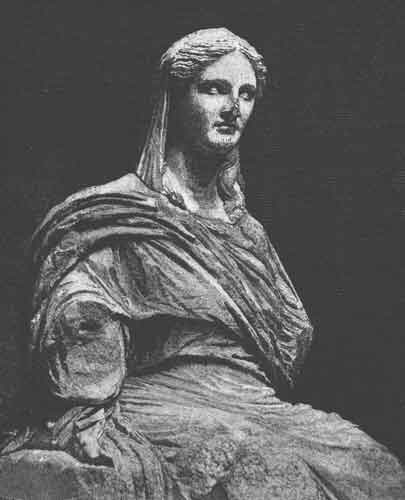
Demeter of Cnidus

Demeter and Kore, Glyptothek Munich 198
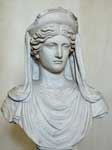

Demeter, Jacobsen collection in Copenhagen

Ceres Enthroned, Michele Pannonio
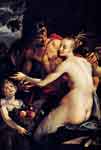
Bacchus, Ceres and Cupid, Hans von Aachen
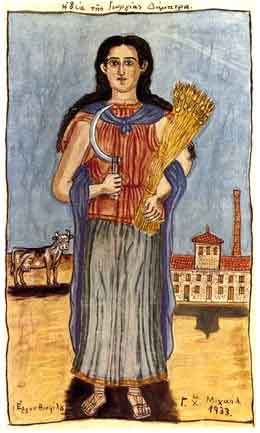
Demeter, Theofilos
Tennyson Alfred Lord (Demeter and Persephone )
References
- Jane Ellen Harrison, Prolegomena to the Study of Greek Religion, 1903
- Karl Kerenyi, Eleusis: archetypal image of mother and daughter, 1967.
- Dionysos: Archetypal Image of Indestructible Life, Carl Kerenyi
- Greek Religion, Walter Burkert
- Carl Ruck and Danny Staples, The World of Classical Myth, 1994.
Links
"Temple of Demeter" website (http://www.templeofdemeter.com/index.html)
| Olympians |
| Zeus and Hera |
| Poseidon, Hades, |
| Hestia, Demeter, |
| Aphrodite, Athena, |
| Apollo, Artemis, |
| Ares, Hephaestus, |
| Hermes, Dionysus |
| Chthonic deities |
| Hades and Persephone, |
| Gaia, Demeter, Hecate, |
| Iacchus, Trophonius, |
| Triptolemus, Erinyes |
| Heroes and the Dead |
Carl Kerenyi, Eleusis: Archetypal Image of Mother and Daughter- , Bollingen; Reprint edition (August 12, 1991), ISBN: 0691019150
Gods of the Greeks-, Carl Kerenyi
See also : Greek Mythology. Paintings, Drawings
| Ancient Greece
Science, Technology , Medicine , Warfare, , Biographies , Life , Cities/Places/Maps , Arts , Literature , Philosophy ,Olympics, Mythology , History , Images Medieval Greece / Byzantine Empire Science, Technology, Arts, , Warfare , Literature, Biographies, Icons, History Modern Greece Cities, Islands, Regions, Fauna/Flora ,Biographies , History , Warfare, Science/Technology, Literature, Music , Arts , Film/Actors , Sport , Fashion --- |
Retrieved from "http://en.wikipedia.org"
All text is available under the terms of the GNU Free Documentation License

